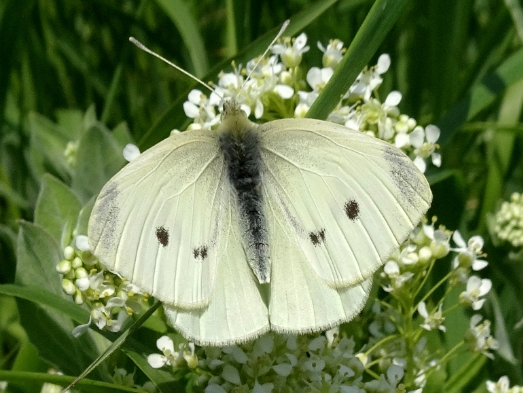
| Butterfly Conservation |
 |
| Hertfordshire & Middlesex Branch |
 |
|
|||
| Saving butterflies, moths and our environment | ||||
_DSC_0535_01July_SCP_43.jpg)

Small WhitePieris rapaeWidespread and common resident Distribution and Status The Small White is a widespread and common butterfly throughout the two counties although it has been apparently absent in the last few years in some of the rural parts of north-east Hertfordshire. Under-recording of the area is the probable cause. Numbers have increased in this decade possibly due to the heavy presence of oil-seed rape. This species is not subject to the same major fluctuations in abundance afflicting the Large White due to parasitism and immigration Habitat Requirements Most habitats but more so on waste ground, gardens and allotments where cultivated brassicas are grown. Fields containing oil-seed rape are also frequented Larval Foodplants Cabbage Brassica spp., Water Cress Rorippa nasturtium-aquaticum. Hedge Mustard Sisymbrium officinale, Garlic Mustard Alliaria petiolata, Hoary Cress Cardaria draba and Wild Mignonette Reseda lutea are also sometimes used Adult Food Sources Buddleia Buddleja davidii, Garden Lavender Lavandula x intermedia, Horseradish Armoracia rusticana, Creeping Thistle Cirsium arvense, Bramble Rubus fruticosus agg.. Burdock Arctium spp. and Black Horehound Ballota nigra are also mentioned Behaviour/Observation notes The Small White is probably the most common 'white' to visit gardens to feed on flowers. In hot and dry weather, aggregations may be found imbibing minerals from mud. It can be confused with the Green-veined White in flight but to the trained eye it might be possible to differentiate them by their behaviour. Small Whites tend to make more purposeful flights but this is by no means a reliable guide. Another clue is the habitat; if it is a damp or shady place it is more likely to be a Green-veined White but again not a hard and fast rule Life History Any warm weather in early spring should accelerate development of the overwintering pupae and adults emerge by early April. The second generation is always larger than the first and is bolstered by Continental immigrants but it is unknown if the immigration is the only or major cause. Eggs are laid singly on a number of wild foodplants under a leaf. Larvae eat the leaves leaving characteristic holes. When fully grown, they move away from the foodplant to pupate on tree trunks, fences and buildings Further information
UK distribution map |
Copyright Butterfly Conservation © 2019 Hertfordshire & Middlesex Branch
Privacy and Copyright Statement and Cookie Policy Statement
Butterfly Conservation
Company limited by guarantee, registered in England (2206468)
Registered Office: Manor Yard, East Lulworth, Wareham, Dorset, BH20 5QP. Tel: 01929 400 209
Charity registered in England & Wales (254937) and in Scotland (SCO39268). VAT No. GB 991 2771 89